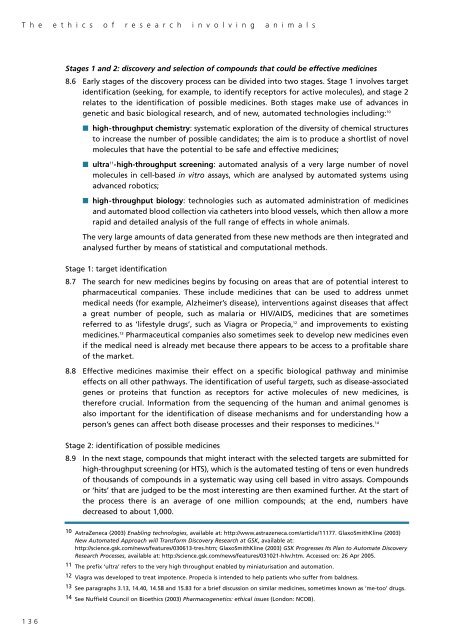The ethics of research involving animals - Nuffield Council on ...
The ethics of research involving animals - Nuffield Council on ...
The ethics of research involving animals - Nuffield Council on ...
Create successful ePaper yourself
Turn your PDF publications into a flip-book with our unique Google optimized e-Paper software.
T h e e t h i c s o f r e s e a r c h i n v o l v i n g a n i m a l s<br />
Stages 1 and 2: discovery and selecti<strong>on</strong> <str<strong>on</strong>g>of</str<strong>on</strong>g> compounds that could be effective medicines<br />
8.6 Early stages <str<strong>on</strong>g>of</str<strong>on</strong>g> the discovery process can be divided into two stages. Stage 1 involves target<br />
identificati<strong>on</strong> (seeking, for example, to identify receptors for active molecules), and stage 2<br />
relates to the identificati<strong>on</strong> <str<strong>on</strong>g>of</str<strong>on</strong>g> possible medicines. Both stages make use <str<strong>on</strong>g>of</str<strong>on</strong>g> advances in<br />
genetic and basic biological <str<strong>on</strong>g>research</str<strong>on</strong>g>, and <str<strong>on</strong>g>of</str<strong>on</strong>g> new, automated technologies including: 10<br />
■ high-throughput chemistry: systematic explorati<strong>on</strong> <str<strong>on</strong>g>of</str<strong>on</strong>g> the diversity <str<strong>on</strong>g>of</str<strong>on</strong>g> chemical structures<br />
to increase the number <str<strong>on</strong>g>of</str<strong>on</strong>g> possible candidates; the aim is to produce a shortlist <str<strong>on</strong>g>of</str<strong>on</strong>g> novel<br />
molecules that have the potential to be safe and effective medicines;<br />
■ ultra 11 -high-throughput screening: automated analysis <str<strong>on</strong>g>of</str<strong>on</strong>g> a very large number <str<strong>on</strong>g>of</str<strong>on</strong>g> novel<br />
molecules in cell-based in vitro assays, which are analysed by automated systems using<br />
advanced robotics;<br />
■ high-throughput biology: technologies such as automated administrati<strong>on</strong> <str<strong>on</strong>g>of</str<strong>on</strong>g> medicines<br />
and automated blood collecti<strong>on</strong> via catheters into blood vessels, which then allow a more<br />
rapid and detailed analysis <str<strong>on</strong>g>of</str<strong>on</strong>g> the full range <str<strong>on</strong>g>of</str<strong>on</strong>g> effects in whole <str<strong>on</strong>g>animals</str<strong>on</strong>g>.<br />
<str<strong>on</strong>g>The</str<strong>on</strong>g> very large amounts <str<strong>on</strong>g>of</str<strong>on</strong>g> data generated from these new methods are then integrated and<br />
analysed further by means <str<strong>on</strong>g>of</str<strong>on</strong>g> statistical and computati<strong>on</strong>al methods.<br />
Stage 1: target identificati<strong>on</strong><br />
8.7 <str<strong>on</strong>g>The</str<strong>on</strong>g> search for new medicines begins by focusing <strong>on</strong> areas that are <str<strong>on</strong>g>of</str<strong>on</strong>g> potential interest to<br />
pharmaceutical companies. <str<strong>on</strong>g>The</str<strong>on</strong>g>se include medicines that can be used to address unmet<br />
medical needs (for example, Alzheimer’s disease), interventi<strong>on</strong>s against diseases that affect<br />
a great number <str<strong>on</strong>g>of</str<strong>on</strong>g> people, such as malaria or HIV/AIDS, medicines that are sometimes<br />
referred to as ‘lifestyle drugs’, such as Viagra or Propecia, 12 and improvements to existing<br />
medicines. 13 Pharmaceutical companies also sometimes seek to develop new medicines even<br />
if the medical need is already met because there appears to be access to a pr<str<strong>on</strong>g>of</str<strong>on</strong>g>itable share<br />
<str<strong>on</strong>g>of</str<strong>on</strong>g> the market.<br />
8.8 Effective medicines maximise their effect <strong>on</strong> a specific biological pathway and minimise<br />
effects <strong>on</strong> all other pathways. <str<strong>on</strong>g>The</str<strong>on</strong>g> identificati<strong>on</strong> <str<strong>on</strong>g>of</str<strong>on</strong>g> useful targets, such as disease-associated<br />
genes or proteins that functi<strong>on</strong> as receptors for active molecules <str<strong>on</strong>g>of</str<strong>on</strong>g> new medicines, is<br />
therefore crucial. Informati<strong>on</strong> from the sequencing <str<strong>on</strong>g>of</str<strong>on</strong>g> the human and animal genomes is<br />
also important for the identificati<strong>on</strong> <str<strong>on</strong>g>of</str<strong>on</strong>g> disease mechanisms and for understanding how a<br />
pers<strong>on</strong>’s genes can affect both disease processes and their resp<strong>on</strong>ses to medicines. 14<br />
Stage 2: identificati<strong>on</strong> <str<strong>on</strong>g>of</str<strong>on</strong>g> possible medicines<br />
8.9 In the next stage, compounds that might interact with the selected targets are submitted for<br />
high-throughput screening (or HTS), which is the automated testing <str<strong>on</strong>g>of</str<strong>on</strong>g> tens or even hundreds<br />
<str<strong>on</strong>g>of</str<strong>on</strong>g> thousands <str<strong>on</strong>g>of</str<strong>on</strong>g> compounds in a systematic way using cell based in vitro assays. Compounds<br />
or ‘hits’ that are judged to be the most interesting are then examined further. At the start <str<strong>on</strong>g>of</str<strong>on</strong>g><br />
the process there is an average <str<strong>on</strong>g>of</str<strong>on</strong>g> <strong>on</strong>e milli<strong>on</strong> compounds; at the end, numbers have<br />
decreased to about 1,000.<br />
10 AstraZeneca (2003) Enabling technologies, available at: http://www.astrazeneca.com/article/11177. GlaxoSmithKline (2003)<br />
New Automated Approach will Transform Discovery Research at GSK, available at:<br />
http://science.gsk.com/news/features/030613-tres.htm; GlaxoSmithKline (2003) GSK Progresses Its Plan to Automate Discovery<br />
Research Processes, available at: http://science.gsk.com/news/features/031021-hlw.htm. Accessed <strong>on</strong>: 26 Apr 2005.<br />
11 <str<strong>on</strong>g>The</str<strong>on</strong>g> prefix ‘ultra’ refers to the very high throughput enabled by miniaturisati<strong>on</strong> and automati<strong>on</strong>.<br />
12 Viagra was developed to treat impotence. Propecia is intended to help patients who suffer from baldness.<br />
13 See paragraphs 3.13, 14.40, 14.58 and 15.83 for a brief discussi<strong>on</strong> <strong>on</strong> similar medicines, sometimes known as ‘me-too’ drugs.<br />
14 See <str<strong>on</strong>g>Nuffield</str<strong>on</strong>g> <str<strong>on</strong>g>Council</str<strong>on</strong>g> <strong>on</strong> Bio<str<strong>on</strong>g>ethics</str<strong>on</strong>g> (2003) Pharmacogenetics: ethical issues (L<strong>on</strong>d<strong>on</strong>: NCOB).<br />
136
















